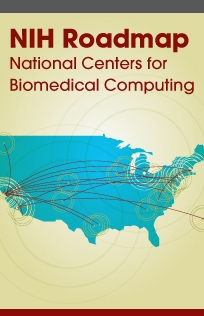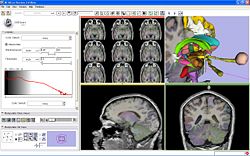Difference between revisions of "Events:August 2008 NCBC AHM"
(→Tools) |
(→DBPs) |
||
| Line 36: | Line 36: | ||
==DBPs== | ==DBPs== | ||
A short summary of the original and renewal DBPs (this will also be used in the DBP sig breakout session). Basically title and one paragraph description. | A short summary of the original and renewal DBPs (this will also be used in the DBP sig breakout session). Basically title and one paragraph description. | ||
| + | |||
1) During the first three years of NA-MIC, Core 3 consisted of four DBPs which were grouped into two thrusts. | 1) During the first three years of NA-MIC, Core 3 consisted of four DBPs which were grouped into two thrusts. | ||
*Thrust 1 was directed by Drs. Shenton and Saykin. Thrust 2 was directed by Drs. Potkin and Kennedy. The focus of the research was to utilize neuroimaging tools to evaluate fronto-temporal connectivity abnormalities in schizophrenia, as well as abnormalities in hemispheric connections (i.e., corpus callosum), and abnormalities in the anterior limb of the internal capsule. Improved segmentation techniques, coregistration of structural MRI, DTI-MR, and fMRI, as well as novel processing tools for evaluating white matter fiber tracts and interregional functional connectivity were needed to accomplish these goals, and they were developed in conjunction with Cores 1 and 2. | *Thrust 1 was directed by Drs. Shenton and Saykin. Thrust 2 was directed by Drs. Potkin and Kennedy. The focus of the research was to utilize neuroimaging tools to evaluate fronto-temporal connectivity abnormalities in schizophrenia, as well as abnormalities in hemispheric connections (i.e., corpus callosum), and abnormalities in the anterior limb of the internal capsule. Improved segmentation techniques, coregistration of structural MRI, DTI-MR, and fMRI, as well as novel processing tools for evaluating white matter fiber tracts and interregional functional connectivity were needed to accomplish these goals, and they were developed in conjunction with Cores 1 and 2. | ||
Revision as of 12:32, 5 August 2008
Home < Events:August 2008 NCBC AHMAgenda
There will be a all hands meeting for the NCBC program at NIH.
* The dates are August 13-14 and the location will be on the NIH campus
|
NA-MIC is one of the National Centers for Biomedical Computing
| |

| ||
NCBC Presentation Materials
Russ Altman will be giving a 10 minutes overview over the entire NCBC program. He has reqested from each of the NCBCs the following information about accomplishments.
DBPs
A short summary of the original and renewal DBPs (this will also be used in the DBP sig breakout session). Basically title and one paragraph description.
1) During the first three years of NA-MIC, Core 3 consisted of four DBPs which were grouped into two thrusts.
- Thrust 1 was directed by Drs. Shenton and Saykin. Thrust 2 was directed by Drs. Potkin and Kennedy. The focus of the research was to utilize neuroimaging tools to evaluate fronto-temporal connectivity abnormalities in schizophrenia, as well as abnormalities in hemispheric connections (i.e., corpus callosum), and abnormalities in the anterior limb of the internal capsule. Improved segmentation techniques, coregistration of structural MRI, DTI-MR, and fMRI, as well as novel processing tools for evaluating white matter fiber tracts and interregional functional connectivity were needed to accomplish these goals, and they were developed in conjunction with Cores 1 and 2.
- Findings from this project, which involve both structural and functional information about brain abnormalities in schizophrenia, were correlated with neurocognitive, clinical, and behavioral data in order to understand further the relationship between brain abnormalities and cognition/behavior in schizophrenia.
2) Starting with the 4th year of NA-MIC, the DBPs were shifted from schizophrenia to lupus, autism, velocardiofacial syndrome (VCSF), and prostate cancer.
- These DBPs now drive the computational research within NA-MIC. Specifically: Drs. Jeremy Bockholt and Charles Gasparovi at the MIND Institute and the University of New Mexico are analyzing brain lesions in Neuropsychiatric Systemic Lupus Erythematosis, Drs. Heather Hazlett and Joseph Piven at University of North Carolina, Chapel Hill are conducting a longitudinal MRI study of early brain development in Autism, Dr. Marek Kubicki at Harvard Medical School is investigating VCSF as a genetic model for schizophrenia, and Dr. Gabor Fichtinger at Queens University is developing a robotic percutaneous surgery system for treatment of prostate cancer.
Publications
1) A few key journal publications that have emerged directly from each center (say the top 5 per center). These should not be presented in a center-specific context but just to show the volume and quality of scientific production. You should be able to get these directly from your progress reports.
- We are gathering statistics about downloads from our publications database. See here for an up-to-date view.
- This are the top five papers from our database in terms of number of downloads between September 2007 and July 2008
2) Some statistics of publications: total number in the last year or cumulative. Again, these should be presented in aggregate rather than by center.
- 198 cumulative publications. http://www.na-mic.org/pages/Special:Publications?collection=12
- See also here for a geographical distribution of the downloads. This link is sometimes slow.
Tools
A list of tools produced by the center with one or two highlights where you have high volume download or many journal citations.
- NA-MIC Kit, which includes 3D Slicer, a popular visualization package (see here for un-curated download statistics--it is helpful if you sort by number of downloads to see the full impact).
Outreach
- List of conferences/meetings where people in your center have explicitly advertised or demoed the NCBC’s activities.
- MICCAI, RSNA, Human Brain Mapping, IGT Workshops at NIH
- Newsletters, conferences, and other activities promoted by the centers.
- The semi-annual hands-on event called the "NA-MIC Project Week".

